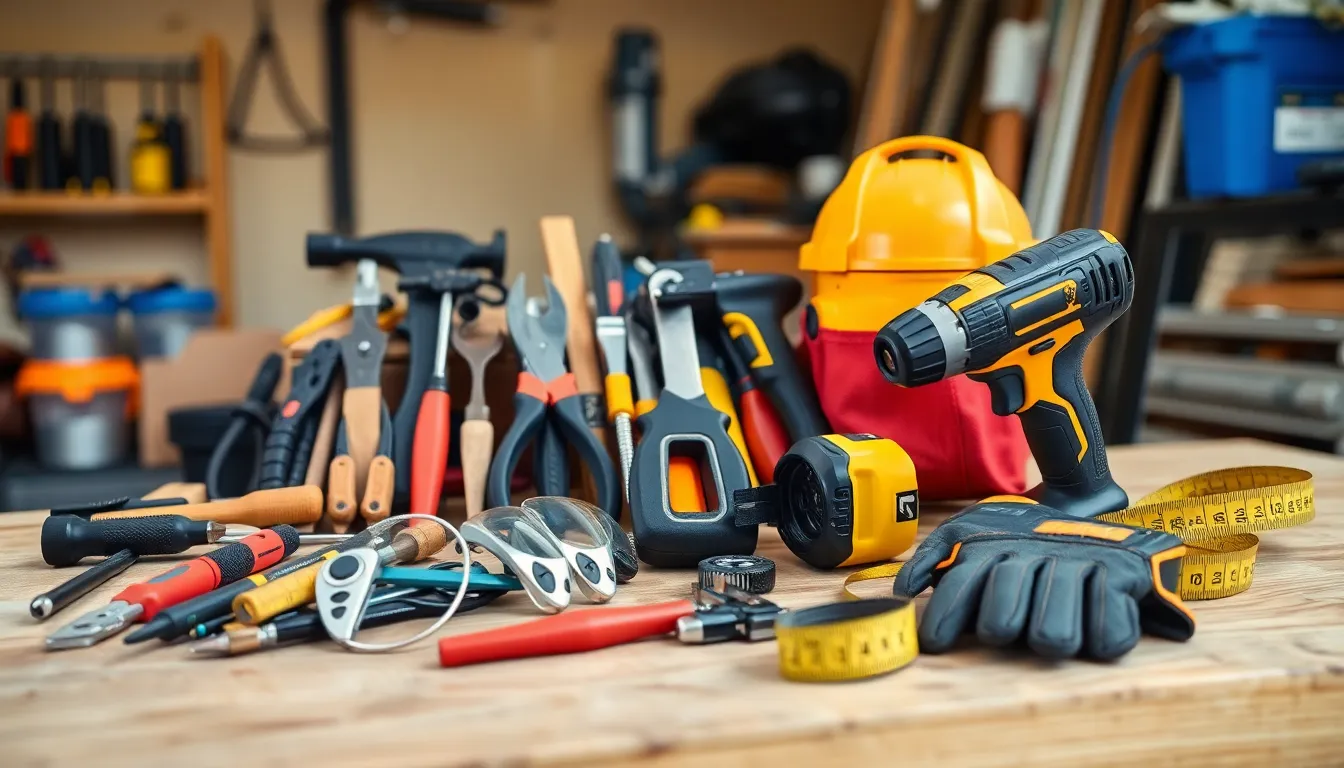Every homeowner knows the importance of having a reliable home repair toolkit. Whether it’s fixing a leaky faucet or assembling furniture, the right tools can make all the difference. A well-stocked toolkit not only saves time and money but also empowers individuals to tackle repairs with confidence.
From basic hand tools to essential power tools, understanding what to include in a home repair toolkit is key. With a bit of planning and organization, anyone can create a collection that meets their specific needs. This article explores the must-have tools and tips for building a versatile home repair toolkit that prepares homeowners for any project that comes their way.
Table of Contents
ToggleOverview of Home Repair Toolkit
A home repair toolkit contains essential tools designed for various repair tasks throughout the home. Having a well-organized toolkit enables individuals to address common issues quickly and efficiently. Key benefits include reduced dependence on professional services and enhanced skills in handling minor repairs.
A typical home repair toolkit includes tools such as:
- Basic Hand Tools: Screwdrivers (both flathead and Phillips), hammers, wrenches, and pliers form the foundation of any toolkit, facilitating numerous tasks from assembling furniture to tightening loose fixtures.
- Measuring Tools: Tape measures and levels ensure precision when making adjustments or installations. Accurate measurements lead to better outcomes in home projects.
- Power Tools: Drills and saws provide additional capabilities for more complex tasks. While handy, users must employ them with care and follow safety guidelines.
- Fasteners and Anchors: Nails, screws, and wall anchors support hanging items securely. Selecting the appropriate fastener prevents damage during installation.
- Safety Gear: Gloves, goggles, and ear protection reduce the risk of injury. Prioritizing safety enhances the overall repair experience.
Equipping a home with a diverse repair toolkit encourages homeowners to tackle repair tasks independently. Considering specific household needs helps determine which tools to prioritize.
Essential Tools in a Home Repair Toolkit

A well-equipped home repair toolkit includes a range of essential hand and power tools. These tools enable homeowners to manage a variety of repairs effectively and efficiently.
Hand Tools
Hand tools serve as the backbone of any home repair toolkit. The following items are crucial:
- Screwdrivers: Include both flathead and Phillips head types. These tools facilitate the tightening or loosening of screws.
- Hammers: Choose a claw hammer for standard tasks. It’s ideal for driving nails and removing them.
- Pliers: Include needle-nose and slip-joint pliers. They help grip, twist, and cut wires and small hardware.
- Wrenches: Equip a set of adjustable wrenches and socket wrenches. These tools are essential for turning nuts and bolts in various plumbing or mechanical applications.
- Tape Measure: A 25-foot tape measure provides ample length for most measuring tasks, ensuring accuracy in cuts and installations.
- Levels: A standard level aids in ensuring surfaces are perfectly horizontal or vertical, especially during installations.
Power Tools
Power tools enhance the efficiency of home repair tasks. Key items to consider include:
- Cordless Drill: A versatile drill allows for both drilling holes and driving screws efficiently. Opt for a model with adjustable speed settings and an assortment of drill bits.
- Circular Saw: This tool is vital for cutting wood and other materials quickly and accurately. Select a model that is lightweight yet durable for ease of use.
- Jigsaw: A jigsaw accommodates intricate cuts in various materials, including wood, metal, and plastic. Including multiple blade types improves versatility.
- Reciprocating Saw: This saw is ideal for demolition tasks or cutting through tougher materials like metal and heavy wood.
- Sander: An electric sander provides a smooth finish on woodwork surfaces. Consider a random orbit sander for multi-purpose sanding tasks.
By integrating these hand and power tools, homeowners can effectively address numerous repair tasks, empowering them to maintain their living spaces efficiently.
Choosing the Right Home Repair Toolkit
Selecting an appropriate home repair toolkit involves considering various factors that tailor it to specific needs. This includes size, portability, quality, and durability of the tools.
Size and Portability
Size and portability impact the usability of a home repair toolkit significantly. A compact toolkit fits easily in closets or under beds, making it convenient for storage. Portable toolkits, often with handles or cases, allow for easy transport between locations. Homeowners tackling repairs in different areas may prefer toolkits that are lightweight and contain essential tools only. A balance between size and the number of included tools maximizes efficiency while maintaining accessibility.
Tool Quality and Durability
Tool quality and durability ensure a reliable home repair experience. High-quality tools withstand frequent use and resist wear, reducing the need for replacements. Homeowners should choose tools made from robust materials, like steel or high-grade plastic, which can endure tough tasks without breaking. Investing in durable tools saves money over time by minimizing replacement costs. Reputable brands often provide warranties, further assuring purchasers of tool longevity and effectiveness. Prioritizing quality over quantity leads to a toolkit capable of handling a wide range of repair jobs efficiently.
Maintenance Tips for Your Home Repair Toolkit
Maintaining a home repair toolkit ensures longevity and optimal performance of tools. Implementing proactive care can prevent issues and extend the toolkit’s usefulness.
Regular Cleaning
Cleaning tools regularly aids in maintaining their functionality. After each use, wipe down tools to remove dirt or debris. For metal tools, a light coat of oil helps prevent rust. Ensure power tools are unplugged before cleaning, and check for any residue in crevices. Storing tools without proper cleaning can lead to damage, reducing their effectiveness in future repairs.
Tool Storage Solutions
Effective storage solutions enhance access and organization of tools. Use a toolbox with compartments to categorize hand tools and power tools. Magnetic strips can hold frequently used metal tools within easy reach. Consider wall-mounted pegboards for vertical storage of tools, maximizing space and visibility. Portable tool bags provide convenience for small tasks around the house, ensuring essential tools are always on hand. Organizing tools properly reduces the time needed to locate specific items, improving efficiency during repairs.
A well-equipped home repair toolkit is essential for every homeowner. It not only simplifies repairs but also instills confidence in tackling various tasks around the house. By carefully selecting high-quality tools and organizing them effectively, individuals can ensure they’re prepared for any situation that arises.
Prioritizing durability and functionality will lead to a toolkit that stands the test of time. With the right tools at their fingertips, homeowners can maintain their living spaces efficiently and independently. Embracing the DIY spirit can transform daunting repairs into manageable projects, fostering a sense of accomplishment and pride in homeownership.







